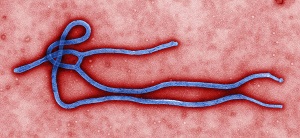 |
| Ebola virus under an electron microscope--Courtesy of CDC |
The ongoing Ebola outbreak in Western Africa underscores the critical need for better global surveillance strategies to combat the emergence of infectious diseases, especially those that have high mortality rates and pose a bioterror threat to countries, according to a new study.
In a comprehensive review published in the journal Viruses, the New York-based nonprofit EcoHealth Alliance says focusing surveillance efforts on viruses in bats, rodents and nonhuman primates could help predict the next pandemic.
"Our scientists have developed a strategy to predict where the next new viruses from wildlife will emerge and affect people. These zoonotic viruses cause significant loss in life, create panic and disrupt the economics of an entire region," said Dr. Peter Daszak, disease ecologist and president of EcoHealth Alliance, in a statement.
Wildlife has been linked to a number of pandemics, including Ebola in previous outbreaks that have sporadically erupted in various parts of Africa. Experts report that the current outbreak--which has so far killed 129 people in Guinea and 13 in Liberia, according to the latest figures from the World Health Organization--is the worst in the past 7 years.
First detected in 1976, Ebola is one of the world's most virulent diseases, with a case fatality rate of up to 90%. There is no cure, and no drugs are available to treat it. The virus is transmitted from person to person through contact with infected blood or bodily fluids, but the origin of each outbreak since the disease's detection has been tied to wildlife.
The recent outbreak has prompted health officials in Guinea to issue warnings against the consumption of bushmeat, or forest game, which may possibly serve as the disease's transmission point from wildlife to human populations.
Researchers turned to wildlife in the Viruses study and reviewed all of the existing literature on filoviruses--the class of viruses that includes both Ebola and Marburg virus--and mapped the geographic distribution of all known bat hosts for these viruses. They found that Guinea and Liberia lie within the expected range of Zaire Ebola, the strain responsible for the current outbreak.
While global surveillance programs like the U.S. Centers for Disease Control and Prevention's Global Disease Detection program and the United States Agency for International Development's Emerging Pandemic Threat Program exist, the study highlights the need for more coordinated global surveillance to monitor outbreak events around the globe in wildlife.
"These global, coordinated efforts may allow us to identify novel viruses that have not yet emerged into human populations and develop prevention strategies to ensure that they do not," the authors say.
- get the press release
- read the study